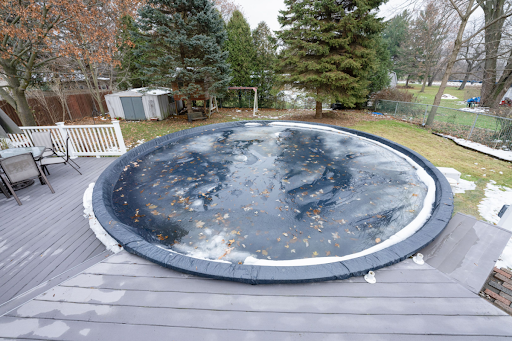While you may not want to go for a swim in the middle of winter, it doesn’t mean you can completely forget about your pool during the off-season. Not only will freezing temperatures damage the pool liner and burst water pipes, but they can also lead to unwanted algae growth. That’s why winterizing a pool should be a part of every pool owner’s schedule yearly. If this is your first year owning a pool and you aren’t sure where to start, here’s how to winterize a pool.
How to Winterize a Pool in 7 Steps
Prepare
Before you learn how to winterize a pool, gathering the necessary equipment for the job is important. Ensure that you have the following:
- Chemicals to shock the pool and alter the chemical composition
- Test kits to determine the pH and alkalinity
- An antifreeze
- Safety gear like goggles and gloves, so you don’t come into contact with cleaning chemicals
- Cleaning equipment, whether they be a pool brush or vacuum
- A swimming pool cover
Store
Next, it’s time to remove all of the pool accessories and store them away for the winter. Wash them off with a hose and dry them so they’ll be clean and ready to use come spring. Be sure to place your pool accessories in a shed, basement, or another safe place.
Clean
Now, it’s time to thoroughly clean the pool. Using a pool vacuum or net, collect all the leaves, dead insects, and other debris. Also, be sure to brush the sides of the pool free from dirt. Make sure to clean the pool early in the winterizing process, as it will be easier to balance the water chemistry and conduct tests later on.
Shock
No pool owner wants to open their pool in the spring and find that it’s become a haven for algae and bacteria. Therefore, it’s a good idea to shock the water with a heavy dosage of algaecide while winterizing. Consider shocking the pool several days prior to completing the process, as that will give the water’s chemical levels time to normalize before testing them.
Test
One of the most important steps in knowing how to winterize a pool is testing the water chemistry. That way, when you close the pool for the season, you can be confident that there won’t be any chemical-related problems you’ll have to deal with in the future. Ensure that the pH of the water is between 7.2 and 7.6, and look at the alkalinity levels too. If you find anything out of the ordinary, use chemicals to adjust the water as you see fit.
Drain
If you want the safety cover to remain stable and fit tightly throughout the winter, it’s a good idea to lower the water levels slightly. Perhaps more importantly, it’s essential to drain the pool equipment as well. When water freezes, it can expand and damage pool lines, pumps, heaters, blowers, and other key equipment. In addition, this would be a good time to use antifreeze if you have it, as it will help prevent cracking and other forms of damage.
Cover
As many can guess, the last step in learning how to winterize a pool is placing a cover over it. This will stave off the elements and inhibit algae growth. However, know that solar blankets cannot be used as a substitute for a cover. A proper safety cover can prevent leaves and other debris from falling into the pool, while a winter cover will shield the liner and help prevent it from tearing apart during storms.
How to Winterize an Above-Ground Pool
While many steps, like shocking, measuring the chemical levels, and putting the cover on, remain the same, above-ground pools are functionally very different. Those who own an above-ground pool should drop the water level around four inches below the skimmer, unscrew the inlet, add a winterizing plug in its place, and remove all the drain hoses from the pool.
Anyone looking for more above-ground pool supplies and other services can trust Island Pools & Patios. We’re leading patio and pool installers in South Jersey that can help out homeowners in more ways than one. Contact us today to learn more!

